Surveying and geomatic engineering collection
Our historical geomatics collection includes examples of types of instrument used for astronomical, angular and distance measurement, together with instruments for the computation, plotting and presentation of the survey data.
-

Gunter Chain
Gunter Chain
Originally manufactured in England. One hundred links in length (approximately 20 metres.) Used for measurement of land boundaries in Victoria up to the late 1800’s when it was replaced by the long steel band. Tags are attached indicating 10, 20, 30 and 40 links from each end. Note that there are 8 wearing surfaces for each link (800 in the 100 link chain), Note also that each individual ‘link’ is pressed but not welded. The chain will stretch under tension or through wear in the links. The surprisingly accurate results obtained with this primitive measuring device reflects credit on the early surveyors.
Each surveyor was supposed to keep a second Gunter’s chain for comparison as a standard. Note that this chain has had a spare link removed from each end due to the fact that it has stretched with use.
-

Steel measuring band
Steel measuring band
Developed in Australia to suit local conditions.
Manufactured locally to order, in various lengths and configurations. Common lengths were 300 feet, 500 links and 100 metres. Usually graduated with a brass tag at each unit of 10 and a copper tag at each 100. The last 10 at each end was graduated in smaller units. These bands were normally used in the field with a spring balance to maintain a constant tension and air temperature was measured and a correction applied to the measured length due to temperature variation from the standard 20°C (68°F). Each tape was regularly compared with a standard tape and any necessary correction applied. These long steel bands were in regular use until the advent of Electronic Distance Measuring equipment in the 1970’s. The long steel band was developed by an Australian Surveyor, reputedly by the use of wire from his wife’s crinoline skirt. Surveyors usually carried a pre soldered metal sleeve so that a broken band could be repaired in the field.
This example is band No. 42 of the Country Roads Board (CRB), later VicRoads.
-
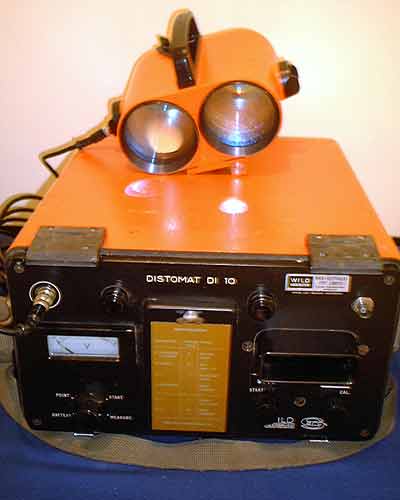
Distomat DI10
Distomat DI10
Serial No. 53119
Manufactured by Wild Switzerland.The DI10 was the first of the short range (1–2 km), infrared light, portable electronic distance measuring units. The sending and receiving unit was mounted on the telescope of the theodolite, with the control and power unit beside the tripod. The first DI10 in Victoria was purchased by the Melbourne and Metropolitan Board of Works in the early 1970’s.
Courtesy of Sokkia.
-
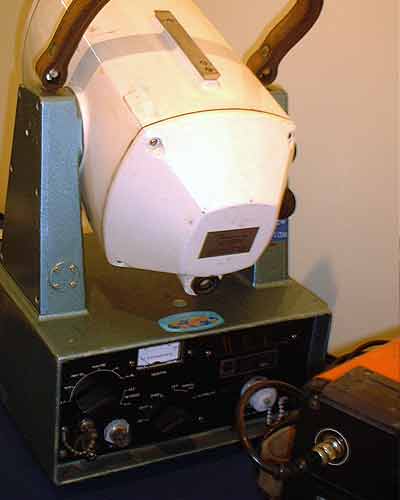
Tellurometer MA100
Tellurometer MA100
MA100 (Modlite)
Manufactured by Plessy South Africa
Serial No. 123This instrument used infra-red light for high precision short range (up to 1 mile) measurement of distance.
This particular instrument was used to establish the control survey over Dartmouth Dam Site, a particularly steep valley, where positions required during construction of the dam were to be fixed by resection. (Purchased by the SR&WSC in the 1970’s.)
Courtesy of The Rural Water Commission, formerly the SR&WSC
-
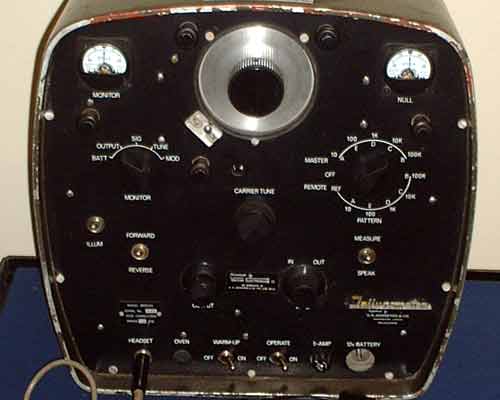
Tellurometer MRA101
Tellurometer MRA101
Manufactured by Plessy South Africa
Serial No.425.Development of the tellurometer in the 1950’s resulted from research into measurement of the speed of light. Availability of these instruments collapsed the then 40 year program for completion of the geodetic survey and 1:250 000 mapping of Australia to about 10 years. The first tellurometers had an oscilloscope to measure the position of the null point, by observing the leading edge of a break in the illuminated circle. The instrument used microwaves to measure lines of up to about 50km. For geodetic surveys in the flat terrain of central Australia, traversing replaced triangulation. Two units in radio contact with each other were required, one at each end of the line being measured. One unit would act as master and the other as slave, the line could be re-measured with the units changing roles. Meteorological observations were made of temperature, pressure and humidity and corrections applied.
-
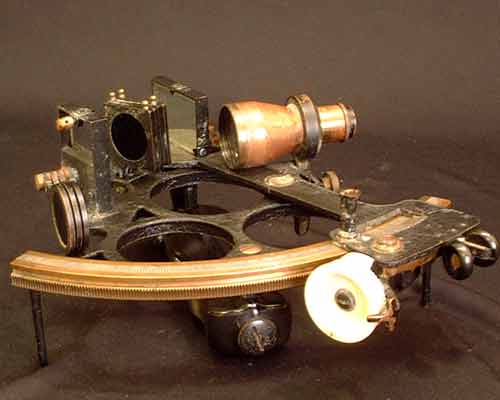
Nautical sextant
Nautical sextant
Hunsun Trade Mark D^D
H Hughes and Son. London.
University of Melbourne Number 6765The sextant is used to measure angles in any plane. Most commonly used to measure the vertical angle from the horizon to the sun or a star in order to determine latitude.
Dark glasses are provided for observations of the sun.
D^D indicates that this sextant belonged to the Department of Defense.
-
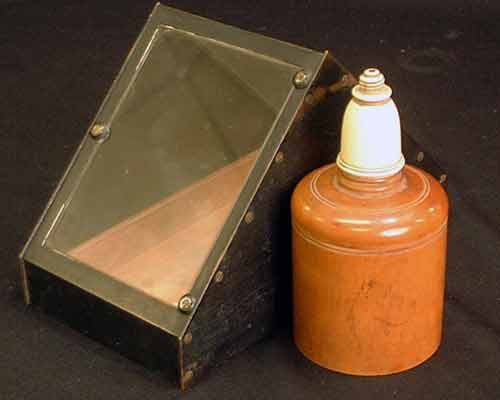
Artifical horizon
Artifical horizon
With special wooden bottle of Mercury.
The artificial horizon comprised a wooden tray containing a layer of mercury to produce a level surface. The tray was under a glass cover to keep the mercury clean and to shield it from the wind. When not in use the mercury was stored in the wooden bottle.
The artificial horizon provided the ability to determine the elevation of the sun or star when the horizon was not otherwise visible. This was achieved by using a sextant to observe the vertical angle between the sun or star and its reflection in the mercury. The resultant angle was halved to obtain the angle of elevation of the sun or star above the horizon. The mercury could be cleaned by running it across a chamois, soft paper or glass rod.
-
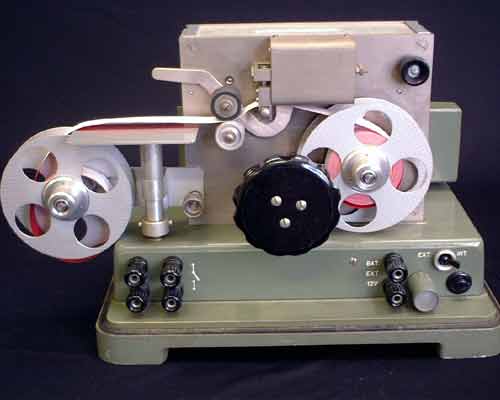
Cronograph
Cronograph
Serial No. 543051
University of Melbourne No. 66631A spring driven timing device capable of accurately recording the progression of time on paper tape. The instrument has the facility to record on the tape the time of a signal from a person observing a star through the telescope of a theodolite.
-
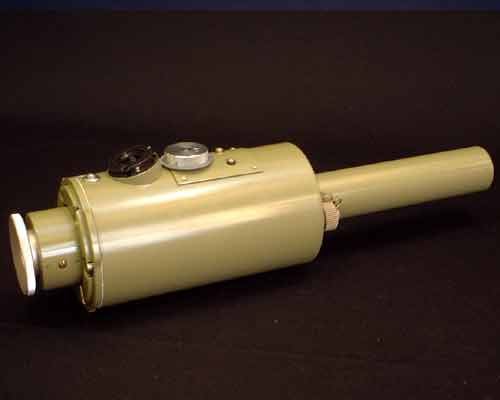
Gyroscope
Gyroscope
Wild GAKI
Serial No.11345The gyroscope is designed to be attached vertically above a Wild T1A, T16 or T2 theodolite. In operation a suspended rotor is driven at speeds in excess of 20 000 rev/minute, the axis of the spin being in a horizontal plane. The gyroscope finds true north and oscillates slowly about that meridian, enabling the theodolite orientation to be determined.
-
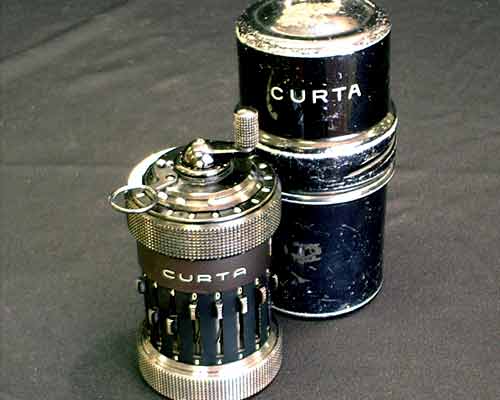
Curta field calculator
Curta field calculator
Made in Liechtenstein. Serial No.40349
The advent of this instrument in the 1950’s greatly facilitated computations in the field by replacing the need to use logarithm tables. It was used extensively until the development of the electronic pocket calculator in the 1960’s.
-

HP programmable computer
HP programmable computer
Serial No. 2206A56711
University of Melbourne No. 54067The programmable desk top computer, capable of being interfaced with various output devices became available in the late 1960’s. These units provided the capability to reduce and process survey data to provide solutions which were not previously possible.
-
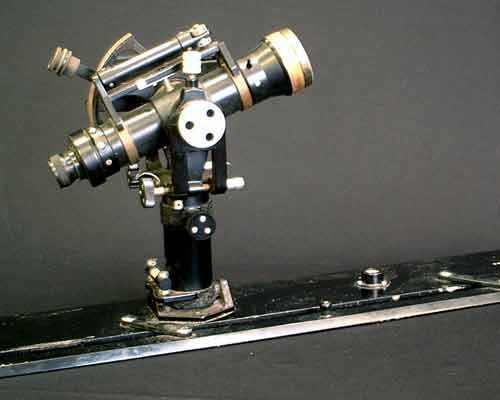
Telescopic Alidade
Telescopic Alidade
E.R.Watts and Son
Serial No. 53750This is an early alidade for plane table surveys with a telescope attached. The telescope has stadia hairs to measure distance from the intercept on a staff and a vertical circle to enable heights to be determined. Circa 1930.
-
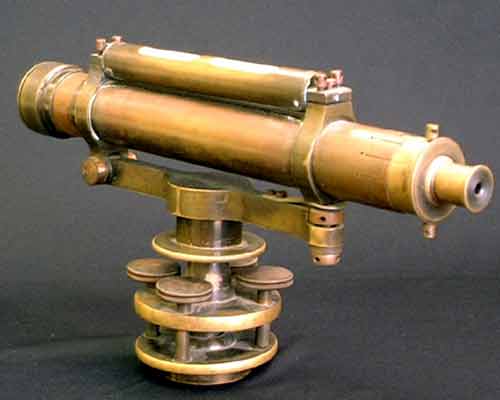
Level
Level
Troughton and Simms
Serial No. 636An early four levelling screw level, many hundreds of which were produced. External focusing.
A very stable instrument. Circa 1880.
This instrument is lacking cross hairs. The cross hairs could be replaced in the field by obtaining fresh spider’s web on a forked stick and laying it across the etched lines on the reticule.
-
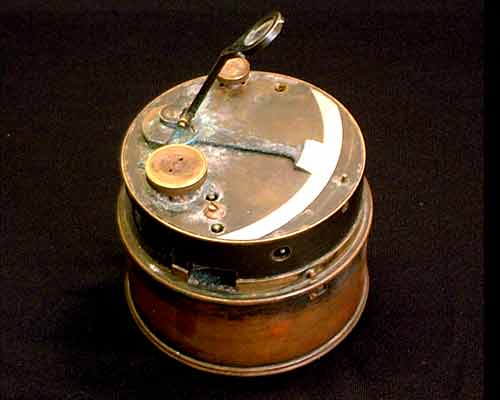
Box sextant
Box sextant
Kilpatrick and Co. London.
Used mainly as an easily portable sextant for measuring vertical angles. Dark glasses provide facility to measure altitude of the sun to obtain latitude. Circa 1880.
-
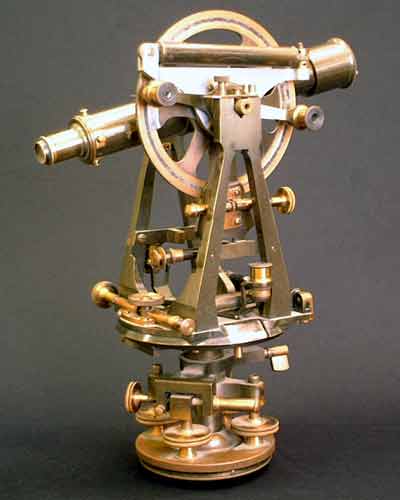
Theodolite
Theodolite
Troughton and Simms
Serial No. 759
Circa 1880.A four screw theodolite, typical of many of its era. This instrument has had comparatively little use and could be restored to excellent condition. This represents the type of theodolite which gradually replaced the circumferenter compass for cadastral surveys in Victoria. In 1873 regulations were issued which required that surveyors must use a theodolite for these surveys.
This is a transit theodolite i.e. the telescope could be rotated to point either forward or backwards.
When properly levelled the basic function of a theodolite is to measure horizontal and vertical angles. It also has the ability to extend a straight line by transiting the telescope and to line in intermediate points along a line.
-
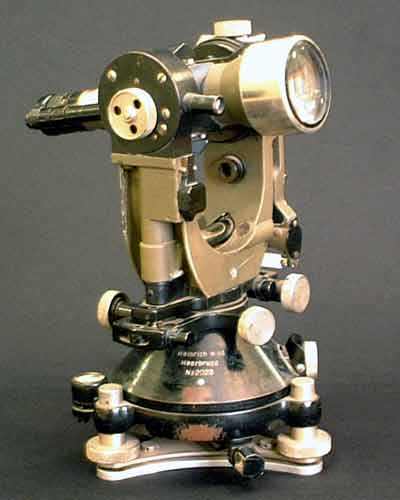
Theodolite
Theodolite
Troughton and Simms
Serial No. 759
Circa 1880.A four screw theodolite, typical of many of its era. This instrument has had comparatively little use and could be restored to excellent condition. This represents the type of theodolite which gradually replaced the circumferenter compass for cadastral surveys in Victoria. In 1873 regulations were issued which required that surveyors must use a theodolite for these surveys.
This is a transit theodolite i.e. the telescope could be rotated to point either forward or backwards.
When properly levelled the basic function of a theodolite is to measure horizontal and vertical angles. It also has the ability to extend a straight line by transiting the telescope and to line in intermediate points along a line.
-

Star globe
Star globe
A.G.Barker, Melbourne.
The star globe enables an observer to determine the azimuth and altitude of any fixed star, at any time, and in his latitude, in a few moments and without computation.
Latitude is set on the meridian scale and the globe rotated to the required time as shown around the equator. Altitude is read from the quadrant and azimuth from the horizontal circle. For the southern hemisphere the globe is reversed.
Detailed instructions are given in the lid.
-

Siderial time chronometer
Siderial time chronometer
Ulysse Narden Swiss
Serial No. 7580
University of Melbourne No. 6637The sidereal time chronometer is designed to keep sidereal rather than solar time. This precise instrument is mounted in gimbals within a glass topped case, which is contained within a padded outer carrying case.
-

Zeiss automatic theodolite
h2 style="color: #ffffff">Zeiss automatic theodolite Manufactured by Carl Zeiss, W. Germany.
Serial No.9900623An Automatic theodolite which measured and displayed distance, horizontal bearing and vertical angle.
-
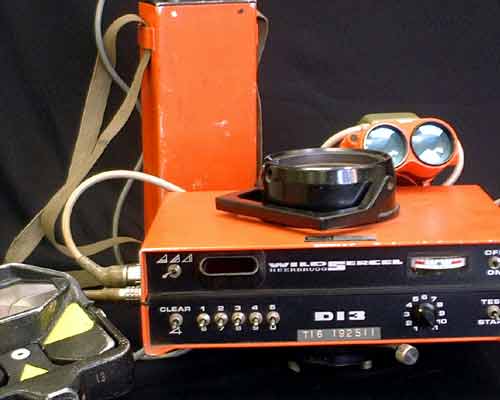
Wild DI3 distance meter
Wild DI3 distance meter
Wild Heerbrugg Switzerland
Serial No. 32181The DI 3 was designed to be mounted on the tripod with the theodolite. The control unit fitted on the tripod, the theodolite on top of the control unit, the sending/receiving unit on the theodolite and the battery on one of the tripod legs.
The unit was more portable than the DI 10 which it replaced in the mid l970’s. A built-in facility provided the ability to reduce distances for slope.
Courtesy of Sokkia.
-
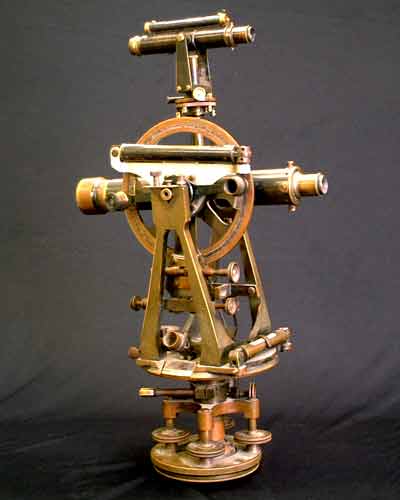
Theodolite
Theodolite
Troughton and Simms
Serial No. 759A Vernier theodolite direct reading to 30 seconds. This instrument has had extensive use and is in poor condition with bent vertical standard. The telescope has a fitting to allow the attachment of an auxillary telescope to allow steep or vertical sights to be made.
The auxiliary telescope is marked Saeg Muller’s Pat. May 8, l981
An auxiliary telescope with bubble attached and provision for a vertical circle (currently missing). The auxiliary telescope attaches to the main telescope of the theodolite at item 62 and enables observations of vertical (zenith or nadir) or near vertical lines which could not be observed through the normal telescope. Mostly used in mining surveys.
-

Auto Reduction Tacheometer
Auto Reduction Tacheometer
Cooke, Troughton and Simms, Ltd.
Serial No. 17846
University of Melbourne No. 6655A Vernier theodolite specifically designed for tachometric survey. Pointers in telescope move automatically with changes in the vertical angle of the telescope, to give direct reduction for height and distance.
-
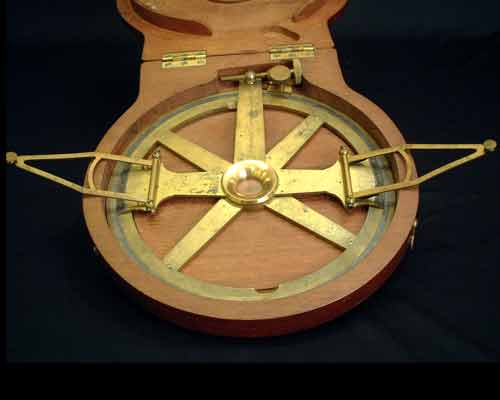
Protractor
Protractor
Negretti and Lambra, London.
An eight inch brass protractor with two vernier arms graduated for direct reading to 20 seconds of arc. A clamp and slow motion screw is provided for reading of the scale. Arms extend to 12 inches for precision of plotting and an etched glass centre is provided for positioning.
-
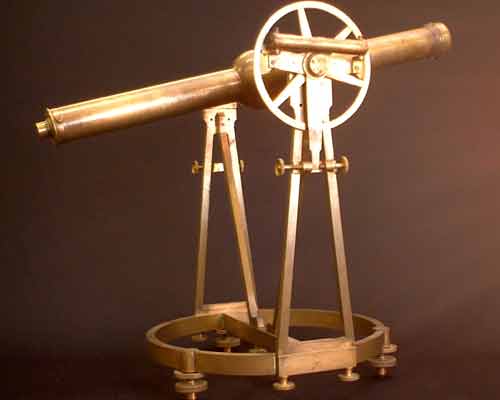
Portable Transit Instrument
Portable Transit Instrument
Troughton & Simms, London
Serial No. SG0 102Six inch circle direct reading to 30 seconds.
Can be reversed in Y’s, face right and face left.
This instrument is normally set in the plane of the Meridian for observing star transits, for time and longitude determination. The use of a striding level for the horizontal axis is essential.
-
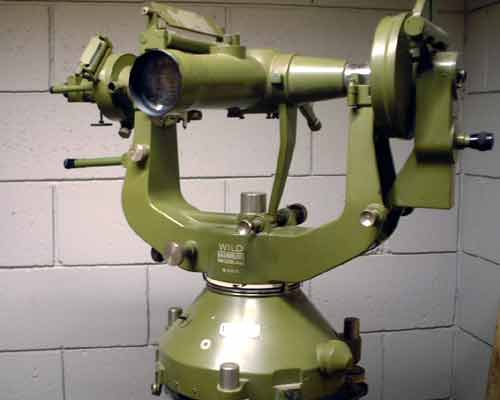
T4 Astronomical Theodolite
T4 Astronomical Theodolite
Manufactured by Wild Heerbrugg Switzerland
Serial No. 22675
University of Melbourne No.24560
Mounted on Tripod in Hallway.This instrument was first produced in 1941. It is specially designed for precise astronomical observations. The image formed by the telescope is viewed through one end of the trunion (horizontal) axis. Readings of both the horizontal and vertical circles are made with an optical coincidence micrometer giving the mean of the readings on each side of the circle. Horizontal circle is 10 inches giving direct reading to 0.1 second of arc and the vertical circle is 3.5 inches reading direct to 1 second of arc.
Significance of the collection
During the entire period of European occupation of Victoria, including the settlement of land and the development of infrastructure, there has been continuing evolution in the nature and precision of measuring instruments available to the surveyor.
Our geomatics collection includes examples of each of the types of instrument used for astronomical, angular and distance measurement, together with instruments for the computation, plotting and presentation of the survey data.
The collection is considered to be the most comprehensive in Victoria and to be significant in Australia. It contains examples of distance measuring equipment ranging from the 100 link Gunter’s chain, through the long steel band (reputedly developed in Australia using wire from the crinoline skirt of a surveyor’s wife) to various electronic distance measurers using microwaves and infra red light waves. Examples of instruments used in astronomical observations in the 1800’s are included, although many of the theodolites used for the triangulation of Victoria during the mid 1800’s continue to be housed in the Science Museum of Victoria.
The collection of theodolites is most comprehensive. It includes the standard brass Troughton and Simms theodolite of the late 1800’s and early 1900’s as well as an example of a mining version of this theodolite with an auxiliary telescope. Both mechanical and optical micrometer theodolites are represented as well as a very early Wild T2 instrument, which incorporated the earliest version of a graduated glass circle. Specialised theodolites include an auto reduction tachometer, a large relatively modern, high precision astronomical instrument and a gyroscope attachment for finding true north in a remote or underground location.
A wide variety of levels are displayed including a Watt’s instrument with a parallel plate micrometer for precision levelling. Two of the more unusual instruments incorporate pools of mercury to create an artificial horizon, one for astronomical observations, the other a zenith plummet to define a truly vertical line.
A notable painting titled ‘The Attributes of a Surveyor’ is included in the Collection. The painting depicts the instruments used by Surveyor Oscar F. Smith and was painted by his grandson Gregory R. Smith.
The artifacts in the collection are housed in a series of glass cases in the hallways of the Department of Infrastructure and can be viewed at all times when the department is open.
Contributor: Dr Ray Holmes
The collection was compiled by Dr Ray Holmes.
The Department of Geomatics acknowledges the contribution of Dr Ray Holmes, former Surveyor General of Victoria and long-standing friend of the Department.
Ray was awarded an Honorary Doctorate of Surveying from the Department of Geomatics in 1994 for his services to the surveying profession in Victoria and the University of Melbourne.